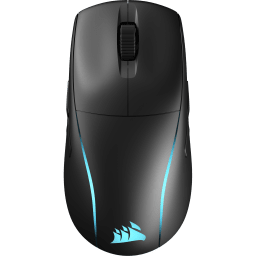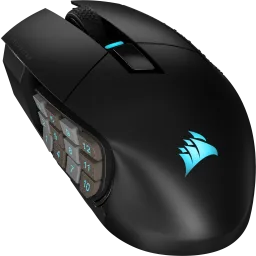Nutidens gaming-mus er mere varierede end nogensinde. Fra funktionsrige gnavere med mange knapper som SCIMITAR ELITE WIRELESS til enkle, præstationsorienterede letvægtsmus som M75 AIR- der er virkelig noget for enhver smag og til ethvert spil.
Uanset hvilken type mus du vælger, er der dog mere funktionalitet til rådighed takket være makroer. Så lad os se på nogle af de bedste makroer, som du bør overveje at bruge til at tilføje et ekstra lag af muligheder til din gaming-mus. Men først og fremmest: Hvad er en makro overhovedet?
Hvad er en makro?
En makro er simpelthen en samling af forudindstillede instruktioner eller en sekvens af instruktioner, som aktiveres med et tryk på en knap. Når det drejer sig om mus, henviser det til et sæt input, der er knyttet til en bestemt knap på din gaming-mus, så når du trykker på knappen, udfører den en bestemt handling eller handlinger.
Nu vil du nok indse den potentielle nytteværdi her. RPG-entusiaster vil tænke på at kombinere sekventielle handlinger i spillet, som de ofte bruger, til en enkelt knap. Til sammenligning vil kontorfolk og folk, der elsker regneark, måske nyde synet af potentielle genveje, der kan gøre deres arbejde hurtigere og nemmere.

CORSAIR SCIMITAR ELITE WIRELESS er en fantastisk gamingmus til makroer, da den har masser af knapper til forskellige makroer. Læs mere om SCIMITAR ELITE WIRELESS her.
Sådan opsætter du makroer på CORSAIR Gaming-mus
Makroer er ikke et nyt koncept, men nu om dage er de meget nemmere at implementere, især via iCUE og en CORSAIR-gamingmus. Lad os se på et par eksempler på makroer, som også bør give dig lidt inspiration til at skabe dine egne musemakroer.
Kontrol af medier
Medmindre du er så heldig at have et tastatur med mediekontrol eller et Stream Deck fra vores brødre hos Elgato, kan det være irriterende at sætte musik, podcasts eller YouTube-videoer på pause og endda slå dem fra, mens du er optaget af noget andet.
Det resulterer som regel i hektisk alt-tabbing, mens du prøver at finde det program eller den side, du vil sætte på pause. Hvis du har en ubrugt museknap, hvorfor så ikke bruge den i stedet? Den er trods alt altid lige ved hånden. Her er en trinvis vejledning i, hvordan du opretter en musemakro til mediekontrol i iCUE med M75 WIRELESS som eksempel.

- Åbn iCUE, og hold musen over modulet, indtil indstillingen "Key Assignments " vises, og klik derefter på den.
- Klik på knappen "+" under fanen "Assignments " nederst til venstre.
- Gå gennem den liste, der åbner sig til højre, find indstillingen "Media", og klik på den.

- Dette vil åbne et par ekstra faner, brug fanen "Key" til at vælge, hvilken museknap du vil aktivere denne makro med.

- Vælg den ønskede indstilling på fanen til højre. Husk, at du kun kan tildele én af disse til hver museknap. Afhængigt af den dybde af kontrol, du ønsker, kan det være nødvendigt at give afkald på flere museknapper.
- Så er du færdig! Husk, at iCUE skal være aktiv, for at disse makroer kan fungere, da de styres via softwaren. (iCUE kan lukkes, men skal stadig køre i baggrunden).
Bemærk: De følgende vejledninger starter alle med de samme indledende trin for at åbne menuen med nøgleopgaver og tilføje en ny opgave. Så vi har udeladt skærmbilleder for disse trin, da du kan henvise til dem ovenfor, hvis du farer vild.
Åbning af en applikation
Lad os sige, at der er et uundgåeligt program på din pc. Uanset hvad du sætter dig ned for at lave, vil denne applikation altid blive brugt. For folk med en dedikeret gaming-pc kan det være Steam. For de mindre heldige kan det være MS Teams eller Outlook.
Uanset hvad, hvis det er et program, du altid bruger, men ikke vil have det til at fylde i mappen med opstartsprogrammer, så lad os binde det til gamingmusen. Fremgangsmåden er stort set den samme som ved opsætning af mediekontroller, så det bliver nemt. Lad os komme i gang.
- Åbn iCUE, og hold musen over modulet, indtil indstillingen "Key Assignments " vises, og klik derefter på den.
- Klik på knappen "+" under fanen "Assignments " nederst til venstre.
- Gå gennem den liste, der er åbnet til højre, find indstillingen "Start app", og klik på den.
- Dette vil åbne et par ekstra faner, brug fanen "Key" til at vælge, hvilken museknap du vil aktivere denne makro med.

- Se nu på listen til højre. Vi har allerede anbragt nogle af de mest almindelige muligheder her, f.eks. forskellige e-mail-apps og webbrowsere, men du kan vælge, hvad du vil. Klik på "+" -tegnet ud for "Vælg app, der skal startes" .
- Dette vil åbne filudforskeren. Du kan søge gennem hele din pc og vælge det program, du ønsker. Alles filsystem er forskelligt, så vi kan ikke give dig specifik vejledning her. Men de eneste filtyper, du kan vælge her, er .exe, .bat, .cmd eller.app. Alle programmer bruger en af disse til at åbne, og .exe er den mest almindelige.
Makro for musebegivenheder
Det er her, vi bliver rigtig smarte, for dette er en makro i ordets egentlige forstand. Vi registrerer simpelthen hver eneste hændelse, som musen oplever. Hvert input fra hver knap, alle bevægelser og hvert klik på scrollhjulet.
Retfærdig advarsel: Du bør kun lade denne makro være aktiv, hvis du ved, hvad du laver. Hvis du aktiverer denne makro utilsigtet, kan det give problemer, afhængigt af hvilken applikation du er i. Den vil afspille det, du har optaget, så din musemarkør vil bevæge sig, scrolle og klikke på ting, mens den fysiske mus står helt stille. Din mus vil dybest set blive besat, så længe makroen varer. Fortsæt på egen risiko.
- Åbn iCUE, og hold musen over modulet, indtil indstillingen "Key Assignments " vises, og klik derefter på den.
- Klik på knappen "+" under fanen "Assignments " nederst til venstre.
- Gå gennem den liste, der har åbnet sig til højre, find indstillingen "Macro", og klik på den.
- Dette vil åbne et par ekstra faner, brug fanen "Key" til at vælge, hvilken museknap du vil aktivere denne makro med.
- Gå til fanen "Makro " til højre. Under underfanen "Generelt" skal du vælge/fravælge, hvad makroen skal optage. Bemærk, at hvis du aktiverer "Forsinkelser ", vil makroen udføre de optagede handlinger med samme hastighed, som de blev optaget med. Hvis du deaktiverer denne mulighed, fjernes eventuelle huller mellem inputtene. Du ved, hvad der er det rigtige, afhængigt af hvad du vil bruge makroen til.

- Når du har justeret indstillingerne, så de passer dig, går du tilbage til fanen "Optagelse". Sørg for, at du har øvet dine handlinger, så du får den rigtige optagelse, og tryk så på den røde knap og optageknappen, og alt, hvad du gør med musen, vil blive optaget, indtil du trykker på stopknappen.

Hvis du har brug for at foretage nogle justeringer eller tilføjelser til makroen uden at optage det hele igen, skal du klikke på de tre prikker ved siden af hver linje, så kommer der en rullemenu frem med nogle få muligheder for at indsætte begivenheder, redigere dem, du har optaget, eller simpelthen slette uønskede begivenheder. Det er en kompleks affære, så det kan godt tage et par gange at få styr på det hele.

Nu ved du, hvad en musemakro er, hvorfor de potentielt er meget nyttige, og du har endda fået et par forslag til at komme i gang.
iCUE er en utrolig stærk software, når det gælder makroer, uanset om det er til mus eller tastaturer. Vi har endda lavet en hel tutorial om optagelse af makroer til Helldivers 2, som virkelig viser potentialet for makroer til at hjælpe med spil, så tag et kig på den for at få lidt inspiration.
Gå ud og se, hvilke makroer du kan skabe. Held og lykke med det.
PRODUKT REGISTRERING


